Editor’s Note: This text course is an edited transcript of a live seminar. Download supplemental course materials.
Brian Fligor: I am excited to present the first webinar in this year’s Expert Seminar Series in Noise-Induced Hearing Loss on AudiologyOnline. While I have developed many materials related to this topic, I wanted to also acknowledge that Mead Killion and the people at Etymotic Research have generously provided me with some material that has furthered my understanding of this topic. I use many images and information that I obtained from Sensaphonics Hearing Conservation in Chicago, and enjoy a collaborative relationship with them. That said, I have no financial or other non-financial interests in either company.
The title of today’s talk is Acceptable Strategies for Prevention of Noise- and Music-Induced Hearing Loss. According to Merriam-Webster, “acceptable” is defined as capable or worthy of being accepted, but “accepted” is defined as generally approved or used. It is also defined on two ends of a spectrum where acceptable can be welcoming and pleasing, but also barely satisfactory or adequate. That is a bit pejorative, but perhaps that is the bar that we are trying to reach.
Quoting from the National Hearing Conservation Association, “Which is the best earplug? The one that you use.” What is acceptable? From a patient’s perspective, one might think using earplugs is acceptable, but the best strategy for preventing noise is one that you cannot feel. It will not limit your freedom. It makes things like music sound just as good as or maybe better than not implementing that strategy, and it is free.
Hearing Loss Prevention Strategies
What are some strategies to prevent noise-induced hearing loss? Elements of a hearing loss prevention program include a noise survey, engineering and administrative controls, audiometric monitoring, education and motivation, and use of hearing protection devices. The noise survey gives an indication if there is a problem that should be investigated in the first place. If so, it is imperative to reduce the sound exposures and correct the problem at the source. That is the engineering. Audiometric monitoring determines what the exposure has done to the person’s ear at baseline. What is it doing every year thereafter? If you have someone who cares about what is happening in their ear, they are going to implement the strategies you provide. If they do not care, none of these four topics will do much good. The most important aspect of a hearing loss prevention program is education and motivation. Hearing protection devices are not the pinnacle of a hearing loss prevention program. In fact, it is the last defense, because it accepts that the first four strategies have not been successful in mitigating risk.
Why do I need to protect my hearing? You may hear this from a patient who is a hunter and has decided the ringing in his ears and the challenge in hearing his grandkids is getting to be too much. These patients may want to use hearing aids, but they do not feel that they need to do anything to keep their hearing loss from getting any worse. All firearms have a peak sound pressure level, depending on the environment, capable of causing an acoustic trauma. One single gunshot is capable of causing cochlear damage. This is why we need a strategy.
You may have patients who like to go to concerts or attend concerts for a living as sound engineers or security guards. Figure 1 is a picture from a large concert venue in Massachusetts. There is a sound level meter that was left on the mixing board by the sound engineer for the band that played before the headliners. Commentary on music quality aside, you can see the sound level was 104 dBA on slow integration.
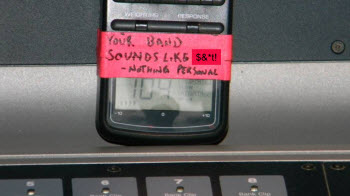
Figure 1. Sound level meter recording at a musical venue during a live concert.
Let’s look at what the audience was exposed to for one concert. Someone in the audience who attended this one show for 4 full hours was exposed to 105 dB equivalent continuous sound level. If unprotected, they would get 50 times their allowable noise exposure for a given day. Some people are going to walk out of there permanently injured. Now think of the security guard who sits at the front of the house or in the middle of the venue, or the crew who is working backstage and as part of the sound checks. When they are loading all of the amplifiers, instruments and equipment, the music is blaring and there are a lot of people shouting. Their equivalent continuous level for this particular instance was 99 dB over 7 hours, which means that they are getting 22 times the allowable sound exposure on a regular basis if they are unprotected. There numbers support the need for a conservation strategy.
Damage Risk Criteria
Damage risk criteria is defined as how loud is too loud and too much for a person’s ear to tolerate. These are guidelines or mandates that will be protective for many people, but, with a certain liberal viewpoint, will still allow some people to develop hearing loss. The Occupational Safety and Health Administration’s (OSHA) damage risk criterion sets a permissible exposure level of 90 dB for an 8-hour time-weighted average with a 5-dB exchange rate. Their permissible level, not safe level, is 90 dB for 8 hours, 95 dB for 4 hours, 100 dB for 2 hours and 105 dB for 1 hour. That is a very liberal allowance, in that it accepts that a certain number of people are going to develop hearing loss.
The National Institute for Occupational Safety and Health (NIOSH) has a recommended exposure level of 85 dBA for an 8-hour time-weighted average with a 3-dB exchange rate. In other words, their criterion is 85 dB for 8 hours, 88 dB for 4 hours, 91 dB for 2 hours and 94 dB for 1 hour. This criterion accepts that 8% of people in the occupational sector are going to develop a material hearing impairment and 92% are not. OSHA accepts that 25% of people will develop a material hearing impairment, and 75% are protected.
The Environmental Protection Agency (EPA) and World Health Organization (WHO) have adopted an exposure limit of 80 dB for an 8-hour time-weighted average with a 3-dB exchange rate. This is the most conservative guideline and prevents hearing loss. It accepts 80 dB for 8 hours, 83 dB for 4 hours, 86 dB for 2 hours, and 89 dB for 1 hour. This is preventative of all noise-induced permanent threshold shifts.
Hearing loss is expensive to eliminate, and we have to be pro-business and allow some people to be exposed, but we are going to pay attention to their hearing. We will check them and require hearing protection where needed. The NIOSH standard is the one that is generally more in line with best practices. If we are talking about children, we would want to adopt the most conservative criterion.
A Rising Generation
Let’s think about one of the most ubiquitous sources of sound exposure. There were about 150 million iPods that were sold prior to the release of the iPhone six years ago. Imagine how that number has multiplied today. Sandra Levey, Tania Levey and I published a study in the Journal of Speech, Language, and Hearing Research in 2011 that looked at in the noisiest city in the United States, which is New York City. We wanted to know what people were doing with their headphones. We constructed some Jolene mannequins (https://www.dangerousdecibels.org/jolene) and calibrated them. We stopped 189 people wearing headphones as they were entering the City University of New York campus. We asked if they wanted to participate in a study and if we could check their headphones. We had them pause their player and told them not to change the volume.
We asked these 189 people questions about their typical listening behaviors per day and per week. Of the individuals who were age 18 to early 50’s, we found that their mean equivalent continuous sound levels from their MP3 player was 87.2 dBA. That means that over half of the people were exceeding the NIOSH recommended exposure level of 85 dB. We suggested that over half of the people were, in fact, at risk for developing a material hearing impairment if they listened at that level longitudinally. The range of intensities was anywhere from 60 dB to 115 dB, which was fairly extravagant. Their weekly exposures were almost identical to their daily exposures, because they used their headphones every day.
We thought that this was concerning and that we should try understand why half of the adults in New York City who use headphones are using them at very high levels. Background noise is something that causes users to turn up the volume. If you provide a headphone that blocks out the outside noise, it will help them to listen at lower levels. Tania Levey is a sociologist and Sandy Levey works with sociologists in her area. They wanted to explore things like demographics, age, sex, racial ethnicity, education, as well as things like mode of transportation (i.e., subway, walking, or riding a bike) in this study (Levey, Levey, & Fligor, 2011). We wanted to find out about users’ awareness of noise exposure and the damaging effects on hearing.
In an extension of this study, we queried others at Union Square in New York City using the same research methodology (Levey, Fligor, Cutler, & Harushima, in press). We asked people their self-identified race or ethnicity, and we had a large variety of profiles, including African, African American, Asian, Caribbean, Hispanic, and White. We looked at what percentage of people were exceeding the NIOSH recommended exposure level. In our first study (Levey, Levey, & Fligor, 2011), the mean equivalent continuous level from listening to headphones was approximately 87 dB, which is over the 85 dB criterion and certainly over the 80 dB criterion, which we know is suggested to prevent all noise-induced hearing loss.
Of those we tested, 60% of Africans exceeded the daily and weekly allowance, 86% of African Americans exceeded the daily and weekly allowance, 60% of Asians exceeded the daily and weekly allowance, 69% of Caribbeans exceeded the daily allowance but only 46% exceeded the weekly allowance, which means they did not listen every day. Of Hispanics, 65% exceeded the daily allowance and 61% exceeded the weekly, and lastly, 37% of Whites exceeded the daily allowance and 34% exceeded the weekly allowance. A multivariate logistic regression analysis found that African Americans using personal listening devices were significantly more likely to be exceeding their recommended exposure level than people with other racial identities. Being younger was also a significant predictor of who was exceeding the daily and weekly noise dose.
Factors that were not significant in predicting who was and was not going to listen too loud for too long were level of education, gender, awareness of long-term noise exposure and the risk of acquired hearing loss, the location of study sample, mode of transportation, type of listening device, and even the preferred music genre.
The sociologists suggested that social identity is, in large part, what determines if someone listens to their headphones too loud for too long. There is a good bit of work that has been explored for ways to reach out to different populations, age groups and ethnicities related to healthy behaviors like not drinking underage or not smoking or smoking cessation; the same could be done for healthy hearing, but we have to understand that what works in one geographic location will not necessarily work in another. These are things to think about.
Acceptable Strategies
This talk is about acceptable strategies. What is acceptable? The strategy should prevent all hearing loss and it should be free. Additionally, you should not be able to feel it. The earbud-style headphone blocks out no outside noise. Some headphones have a non-custom, one-size-fits-many silicone sleeve that does block out some noise. Etymotic Research sponsored some research that Terri Ives and I published back in 2006, which showed that sound isolation does help. If you were to take an ear mold impression and make a custom sleeve for a particular set of earbuds, comfort and isolation can be achieved, so long as the mold is a good representation of the person’s ear. If it is too tight, it may provide sound isolation but not comfort, in which case, we have not achieved acceptability. We could do a whole webinar on comfort of devices in the ear as relates to hearing protection. Blocking out the background noise will keep listening levels significantly lower.
I would suggest that there is not a solid agreement between the audiologist and the patient on what is an acceptable strategy. Each party has a different motivation. The audiologist’s motivation is to prevent all hearing loss and have a grateful patient who will refer more patients.
The patient’s motivation is not to prevent all hearing loss. That might sound silly, but what they want is to avoid suffering the negative consequences of hearing loss. A 4 kHz notch does not bother anyone unless there is tinnitus that accompanies it. A mild 3 to 6 kHz notch will not affect most people unless they are continually communicating in a noisy environment or trying to acquire spoken language. The patient’s view of how much damage is considered acceptable will differ from what the audiologist considers acceptable. The patient wants to achieve the same performance in that activity as they do without the hearing loss prevention program.
How are we going to do that? We cannot tell an aspiring violinist that the sound level they routinely hear from their instrument is about 100 dB so they can only practice for 15 minutes a day, especially when their goal is to become a virtuoso. In his book Outliers, Malcolm Gladwell (2008) suggests that in order to be a virtuoso, you need 10,000 hours of practice in your area. The Beatles obtained these 10,000 hours by playing in clubs in Germany prior to being discovered. Bill Gates developed his virtuosity with computer programming by spending nights and weekends programming on a mainframe computer at his mother’s office. Professional musicians will practice for 10 hours a day. I have performed sound measures from violinists and have seen consistent levels between 90 and 95 dB and 100 and 105 dB for fortissimo passages. Reduced practice time because of noise exposure is not going to allow them to achieve that same pleasure or performance in their activity. Any hearing protection devices that they use have to be comfortable enough for the duration of the activity, which means that the plugs will not reduce pleasure or performance or being able to monitor oneself.
Cost is a significant motivating factor. Users may not necessarily want this for free, but the cost of whatever you do should be in line with the value of what they receive from your service, whether it is consulting or fitting devices or diagnostic services.
We have to limit the occlusion effect, which is part of achieving the same pleasure from an activity. The occlusion effect, especially in vocalists and bands, is a detrimental consequence that has to be managed.
Patients are also motivated by cosmetics. They want to look the part. If you give them circumaural ear protection and they are playing in a punk band, it does not exude the risk-taking behavior that their fans might expect, which will make them less motivated to use the devices.
We talked about how the concert-goers experienced 105 dB continuous exposure for over 4 hours. That is not acceptable when you have 50 times your allowable exposure. From the audiologist’s perspective, the patient is going to suffer negative consequences if they are exposed often enough. What do we do?
Instead of imposing limitations on recreational activities or monitoring hearing at prescribed intervals, which will not protect hearing, one of the things for the educated and motivated person is to be fit with flat-frequency attenuators, or musicians’ earplugs. Michael Santucci and Marshall Chasin, who have worked with musicians for a long time, would argue that these attenuators are better than standard hearing protection devices. However, putting a plug in your ear is not the same as not having a plug in your ear, no matter how flat that response is.
Resonance and Hearing Protection
An open ear does not resonate in the lower frequencies; it starts to resonate at 2500 to 3500 Hz, which results in a resonance peak. If we put a foam earplug in place, it blocks out the high frequencies more than the low frequencies and obliterates the ear canal resonance. A well-fitted musician’s earplug follows the resonance of the natural ear and allows the ear canal resonance to occur in the same spectral location.
If there is a poor seal between the sleeve of the device and the flesh of the ear canal, you will experience acoustic leakage which will result in the absence of sound isolation in the very low frequencies. If the sound bore, which is responsible for one of the aspects of acoustic inductance, is too skinny or too small, it will result in a disproportionate increase of attenuation in the higher frequencies. Anything that deviates from flat attenuation does not sound as good.
The difference between sound on the outside of the ear and the inside is the transfer function of the open ear (Figure 2). This is analogous to the real-ear unaided gain (REUG). If I sweep a tone at a constant level of 85 dB outside of the ear from low frequency to high frequency with a probe microphone down next to the eardrum, I will see a positive gain difference in the response recorded at the eardrum.
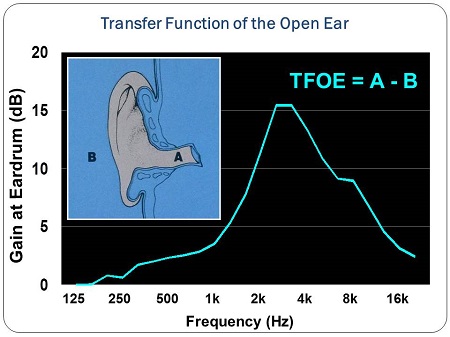
Figure 2. Transfer function of the open ear.
I want to point out that Figure 2 is not to scale; in reality, the bony portion of the ear canal is longer than that. Remember that the outer portion of the canal is cartilaginous and the inner portion towards the eardrum is bony. We are going to talk about construction of earplugs that extend to the cartilaginous-bony juncture, which is roughly at the second bend. This is where the cerumen glands start. You can tell by looking at your ear impression as the surface of the ear mold impression will have small pock marks in it from the pores that you pick up in the cartilaginous portion, and will be smooth in the bony portion. That is an interesting way to tell if you have made the impression deep enough or not. That being said, if the ear plug extends down into the bony canal, it may be uncomfortable.
Figure 3 shows the responses (green) to a pure-tone maximum power output (MPO) sweep at 85 dB when a probe microphone is placed close to the eardrum. If I put a well-fitted musicians plug in place in the left ear, you can see the subsequent response in purple (Figure 3). An arithmetic average in sound isolation across the octave bands showed that this person had an average of 16.4 dB attenuation, with a range from 15 to 21, and a standard deviation of 2.2 dB. The right ear was fairly similar with an average 17 dB sound isolation with a larger range of 12 to 23, and a standard deviation of 3.6 dB. This person loved the sound of their earplugs and they were highly motivated to use them, even though it did not make things sound exactly the same.
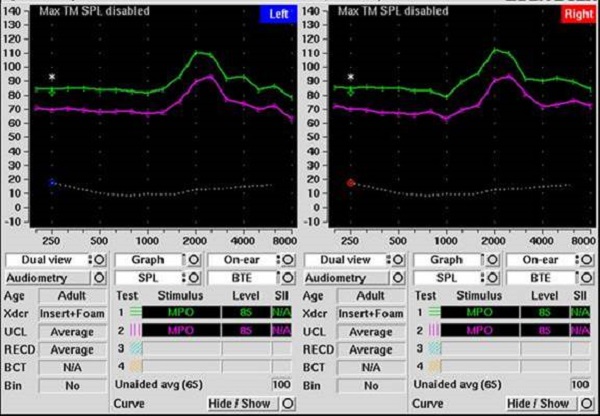
Figure 3. Verification of well-fitted flat attenuation earplugs. Green= unoccluded real-ear response; purple= real-ear response with earplug.
Figure 4 shows an example of a pair of earplugs that had a poor fit and did not meet expectations. This person had a very broad resonance. The left ear was providing 15.5 dB of sound isolation, but the range was 0 to 27 dB, and the standard deviation was 9.2 dB. Based on this fit, I did not even do the computations for the right ear.
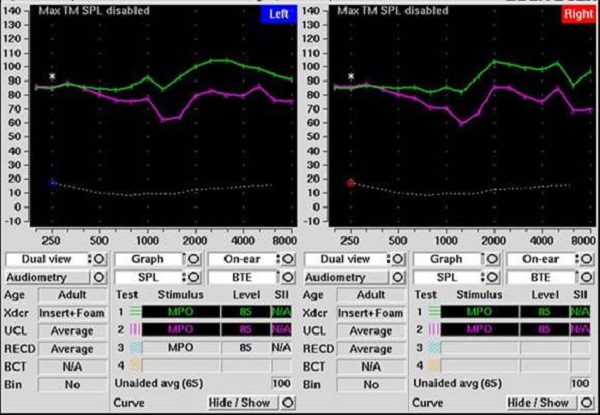
Figure 4. Verification of poorly-fitted flat attenuation earplugs. Green= unoccluded real-ear response; purple= real-ear response with earplug.
Figure 5 shows an example in one individual where the right ear was fit well and the left ear was not. There was not as much sound isolation and a larger standard deviation with poor isolation in the low frequencies on the left side, but the right side was fit very well, with an average attenuation of 15 dB and a standard deviation of 3.5 dB.

Figure 5. Verification of well-fitted (left) versus poorly-fitting (right) flat attenuation earplugs. Green= unoccluded real-ear response; purple= real-ear response with earplug.
Acceptable Earplug Responses
A professor at Berkley College of Music and I are in the process of determining what a musician would consider “acceptable.” Figure 6 shows eight different simulated musicians’ earplug responses, with a perfect 15 dB sound isolation from low frequency to high frequency in the middle. I call that the musicians’ earplug (MEP) 0, because it has a 0 dB standard deviation from low to high. This pink MEP1 (Figure 5) has a deviation of 1 dB, so the standard deviation was 1 dB. We experimented with 2, 3, 4, 6, 8 and 10 dB deviations. The anchor point of the deviations was 1000 Hz; at 1000 Hz, you almost always get the right amount of sound isolation regardless of the plug and the construction. The colored lines reflect the range of musicians' earplugs that I verified in clinic across a couple hundred musicians that I fit.
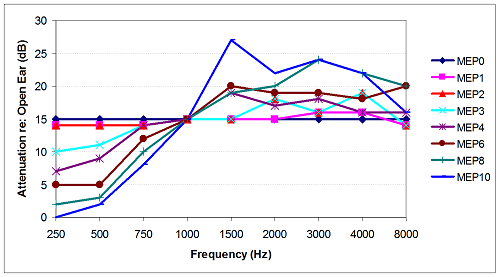
Figure 6. Variations in earplug response by a set standard deviation (see key) around a 1000-Hz fixed point.
I am going to play a sound clip at what we will consider is an “unprotected” level. We are going to listen to some music a little on the loud side. This is open ear, unprotected at 80 dB.

Consider that is the open ear and that we are going to try to avoid unnecessary exposure to high intensity levels. I now want to play an example of a perfectly performing earplug. This has the same sound level, but is filtered through a 15-dB isolator across the frequency range.

You could hear that it was softer, yet the overall frequency response was unchanged. Next, I am going to play for you an earplug that deviates a bit from perfect performance. The overall standard deviation is 3 dB from flat attenuation. Is this acceptable?

Whether or not that is acceptable depends on the patient. If you are an audio engineer doing post-production, that may not be acceptable. If you are a concert-goer who is listening for entertainment, that may be great. Next we are going to listen to an earplug that has a standard deviation of 6 dB.

Does you patient find the earplug to be worth whatever it is that you are charging them? Does the value equal the expectation? This final sound clip is an earplug in which the standard deviation was 10 dB. That is a real earplug that someone brought to my clinic. They told me these were flat attenuators, but I do not think that they are.

Let’s make a comparison. Listen to music clip 2 followed by music clip 5. If we fit earplugs that sound like that and tell the patient that they are flat frequency attenuators, we did not achieve acceptability. This is the impetus behind the study in which I am currently involved. Where is the line drawn between acceptable and unacceptable?
Level-dependent Personal Hearing Protection Devices
Earplugs are not just about passive protection. Sometimes an earplug is a detriment to an activity, such that the user does not feel it is worth using. If we are going to be engaged in strategies to prevent noise-induced hearing loss, we need to think about level-dependent hearing protection devices.
Firearms noise exposure is the number-one cause of recreational noise-induced hearing loss, but consider the range of exposures. Target shooting may be conducted indoors or outdoors, but you are firing several rounds consecutively, versus live game hunting, which is one shot every now and then. You do not necessarily need exceptional situational awareness when you are target shooting and not trying to listen for the rustle of branches our subtle outdoor activity. However, if you are hunting in an open field with a 12-gauge shotgun, that has implications for the need of level-dependent hearing protection.
Communication-Critical Occupations
Firefighters, ambulance personnel and police are exposed to high levels of sound. Military personnel often use firearms. Resource extraction, such as mining and drilling, is a noisy job. I also include vocalists in communication-critical occupations. They need to be able to communicate with their audience in order for them to be successful at their job. If these workers are very successful, and then we do something that interferes with their critical communication, they are not going to find that to be an acceptable strategy.
There are a good number of active and passive level-dependent hearing protection devices (Figure 7). Some are non-custom, circumaural earmuffs that let certain sounds pass through microphones on the outside. There are also communication headsets, with a one-size-fits-most earplug. Fully custom devices by Westone called DefendEars are specifically meant for allowing hunters to hear deer movement from 50 feet away, but damp down the firearm blast. The most cheaply available earplug is the original Combat Arms earplug, where one end is a regular passive hearing protection device, providing a 22 dB noise reduction rating, and the other side provides essentially no noise reduction until you reach a very high intensity sound, like a firearm. It is designed to cause a loss of sound transmission through the ear canal via a turbulent chamber within the plug itself.
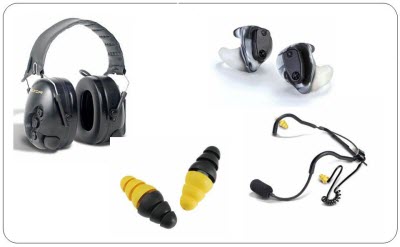
Figure 7. Examples of level-dependent hearing protection devices: (clockwise) non-custom Peltor circumaural, custom DefendEar, communication headset, and non-custom Combat Arms earplug.
Another type of active protection communication device is made by Phonak. This is not a product endorsement, but I wanted to show it to you for the sake of example (Figure 8). There are hard-vinyl, custom ear pieces, but it also has a communication headset. Field data shows that this device, in the dynamic setting, allows exceptionally good communication in many levels of background noise (Association of VA Audiologists, 2011). By comparison, a common foam earplug greatly decreases word recognition ability. If you are having difficulty with word recognition, it interferes with your communication. If someone is yelling you at you that the enemy is to the south, you have to be able to hear those phrases. People in the military, in resource extraction, and first responders need to be able to communicate in high levels of noise. Hearing protection devices are not acceptable if they are impairing performance like this.
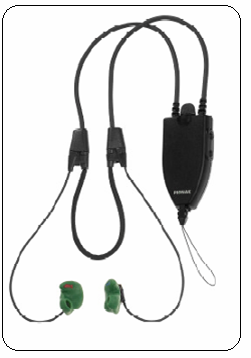
Figure 8. Active hearing protection communication device (Phonak Serenity DP).
Compared to other musicians, vocalists may have the most difficulty adjusting to musicians' earplugs. Vocalists need to monitor communication while wearing hearing protection. They need to monitor themselves and they need to hear the audience just as much. There is a certain exchange between performer and audience that needs to be heard and observed by the performer. If the vocalist has in-ear monitors that allow him to hear as well he we would in the studio and block out all background and audience noise, which is a good 95 to 100 dB at even small venues, those will interfere with the performer’s ability to monitor their own performance. Therefore, they will turn up their on-stage monitors, which are loud speakers pointed back at them, to have an adequate signal-to-noise ratio in order to hear themselves. In these cases, damage risk criteria is exceeded. When we choose to fit in-ear monitors, they may be able to monitor themselves beautifully, but we have also given them hearing protection devices that cut them off from the audience.
One way to fix that is to take one in-ear monitor out and leave the other one in, but that results in loss of binaural summation. Furthermore, by not wearing both in-ear monitors, you have also exposed the other ear to the levels on stage. A 3D active ambient in-ear monitor (Figure 9) has a hearing aid microphone with a high peak-input clipping level - high enough that the drums and the crash symbol does not cause the microphone to saturate. I use these as programmable hearing protection devices because I can dial down how much sound the hearing aid mic allows in. It has pass-through sound isolation at 0 dB, but I can adjust seven clicks around the dial with 4, 8, 12, or 16 dB sound isolation. That allows that front man to have some sound exposure, but you can moderate how much sound exposure they are going to have and still maintain a good enough signal-to-noise ratio.

Figure 9. 3D active ambient in-ear monitors (Sensaphonics).
Summary
What is acceptable? Is it barely satisfactory or adequate? Capable and worthy of being used or welcoming and pleasing? We must consider where our definition meets the patient’s definition. First off, I would argue that we cannot compromise on our goals of the hearing loss prevention program, but finding those goals is a conversation between the audiologist and the patient. We must find the right trade-off between performance and comfort.
As discussed, a plug with a tight seal that fits deep in the canal limits the occlusion effect and limits the amount of leakage and loss of sound isolation. However, that can impinge on comfort. The ear canal is a dynamic structure and can be tricky to navigate. Taking an ear mold impression past the second bend requires experience under the effort of trained audiologists. It might be more pleasant to have a shallow or loose-fitting earplug, but that is ultimately going to impair performance of that plug.
An acceptable protection device will allow the user to maintain communication and situational awareness. Think about someone who needs to be able to hear the back-up alarm on a forklift in their noisy environment. People have been killed by having overprotected ears. They were not able to hear the warning signals or maintain situation awareness.
The user should have the freedom to pursue their passion safely. This is something that allows a teenage musician who wants to become a virtuoso violinist to practice two hours a day, but not have tinnitus after she is done playing. An acceptable strategy is giving a person who has noise-induced hearing loss and tinnitus the freedom to continue their chosen profession, but in a way where sound exposures are not going to cause greater damage and negative consequences.
Questions and Answers
When using flat-frequency attenuators, how would the music sound to a person with a moderate, high-frequency hearing loss?
That person will experience some loss of the overtones and brightness, but it depends on how much hearing loss they have been 3 and 8 kHz. If it is a purely sensorineural loss, the equal loudness contours will indicate that a high enough sensation level above their loss will sound the same or nearly the same as it would to a person with normal hearing.
Have you calculated what a poorly-fitting musician earplug does to the in-ear dBA level?
Yes I have. It depends on what the frequency response is. If you have a lot of low-frequency sound, and you do not have adequate sound isolation, you are under-protecting in that instance. That gets into issues where you say you have a 15-dB sound isolator and in fact, it is more like a 3 or 4 dB isolator for the kind of sound exposure you are experiencing. This is another reason why you have to verify these plugs. It is not just for sake of the performance and how it sounds to the individual, but to verify whether or not you are providing safety. When you tell a person that a musician’s earplug will give them 15 dB of sound isolation and that they are safe to be in a club for 2 hours, you had better be sure. When they develop a noise-induced hearing loss and you did not verify the fitting, you may be on the hook for a malpractice lawsuit.
Do you perform open-jaw earmold impressions on musicians?
Yes I do. The ear canal is a dynamic structure, and as you open and close your jaw, there is a change in shape between the aperture of the ear canal and the first bend. In fact, for most people, the canal gets smaller as the jaw opens because the lateral wall edges inward. That said, I do not leave the jaw completely open or use a bite block. Just as I am filling up the ear canal, I have them open their mouth. When I finish filling up the canal and I am starting to fill up the concha bowl, then they can close. I have had some fit issues with certain musicians who say there is no way plugs will ever fit because they have tried them multiple times. Think of what instrument they are playing. Someone playing a reed instrument has their mouth in an odd position - not wide open or closed. There was a trombonist who never had comfortable fitting earplugs, so I tried making the ear mold impressions while he was playing. They worked extremely well and were a great fit.
Would it be wise to take open and closed jaw impressions?
I do not know about open and closed, but give it a try if they are not fitting quite well either way.
Do you have any experience with occupational noise-induced hearing loss in Canada?
I personally do not. However, I would recommend attending the National Hearing Conversation Association meeting. There are many Canadian audiologists and Canadian Industrial Hygienists who come to that. There is such phenomenal work done in Canada for understanding occupational noise-induced hearing loss.
One of the studies that you showed earlier said that there was no significant impact on risk awareness of noise by educating people about the noise risk. Are we wasting our time trying to educate people about this?
A lot of people know that headphones can cause hearing loss, but just knowing that does not necessarily translate to changes in behavior. A standardized curriculum like Dangerous Decibels teaches people about how sound exposure can damage their hearing and how to turn it down or walk away and develop an appreciation for how the ears work. Published data indicates that standard curricula does reduce risky behaviors of people who have gone through that kind of program. I am not suggesting that we should not bother teaching about it, but we do have to acknowledge that simply stating what is good and what is bad will not translate into changes in behavior. Addressing a person’s social identity and their values might influence how messages are perceived in relative risk profiles. Those are things that can be done to modify their awareness in a way that would, in fact, become significant.
References
Acceptable. (n.d.). In Merriam-Webster.com.
Accepted. (n.d.). In Merriam-Webster.com.
Association of VA Audiologists. (2011). Dynamic hearing protection for people with hearing loss. Retrieved from https://www.myavaa.org/documents/JDVAC-2011-Presentations/Erman_JDVAC2011.pdf
Fligor, B. J., & Ives, T. E. (2006). Does headphone type affect risk for recreational noise-induced hearing loss? Paper presented at the NIHL in Children Meeting, Cincinnati, OH.
Gladwell, M. (2008). Outliers: The story of success. New York, NY: Little, Brown and Company.
Levey, S, Levey, T., & Fligor, B. J. (2011). Noise exposure estimates of urban MP3 player users. Journal of Speech, Language, and Hearing Research, 54, 263-277. doi:10.1044/1092-4388(2010/09-0283)
Cite this content as:
Fligor, B. (2013, December). Acceptable strategies for prevention of noise- and music-induced hearing loss. AudiologyOnline, Article 12205. Retrieved from: https://www.audiologyonline.com


